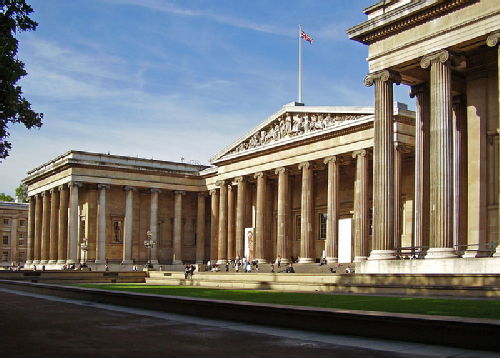A week at the museum: The British Museum’s Numismatics Summer School, 8th–12th July 2013
 The department of Coins and Medals at the BM is easy to miss: beside an indiscrete steel door at the rear of the money gallery, there is a bell which, when pressed, announces your arrival to the sound of trumpets. Inquisitive tourists watch as you enter. Then, as the door is locked, you realise that you have stepped into a giant safe: every room is isolated, while security cameras inspect your movements from above. This is unsurprising, considering the amount of gold and silver which now lies within snatching distance. Any would-be burglar, however, should consider the following before he melts down his loot – a haul of ancient coinage is today worth much more than the sum of its parts.
The department of Coins and Medals at the BM is easy to miss: beside an indiscrete steel door at the rear of the money gallery, there is a bell which, when pressed, announces your arrival to the sound of trumpets. Inquisitive tourists watch as you enter. Then, as the door is locked, you realise that you have stepped into a giant safe: every room is isolated, while security cameras inspect your movements from above. This is unsurprising, considering the amount of gold and silver which now lies within snatching distance. Any would-be burglar, however, should consider the following before he melts down his loot – a haul of ancient coinage is today worth much more than the sum of its parts.
Despite this, the first lesson we learnt at the BM’s Numismatics Summer School was that, to those who first created our western coinage system, the quantity of precious metal was all that mattered – coins had intrinsic value and no more. So why bother with coinage in the first place? Why not continue to value goods in oxen or tripods; or in unworked ingots of silver or gold? Perhaps coins were convenient and facilitated trade; or maybe the local king wanted to promote his own standards: the jury is still out, despite the mass of research into these fundamental questions.
Yet, there is still plenty to be gleaned from the hard evidence. I was absorbed by the statistical analysis of coin hoards, and intrigued by the eye-watering, frustrating and (ultimately) rewarding discipline of die studies. The twin processes of discovery and coin conservation were also described – invaluable insight for any aspiring archaeologist. Numismatics has never been an overpopulated field, but this didn’t turn a week with the experts into one of dry academia. The numismatists at the BM are diverse in both personality and approach; they are all devoted to their subject. Their explanations, both clear and comprehensive, brought the coins in the museum to life.
Over the course of the week we handled gold coinage, silver coinage, bronze coinage and alloyed coinage; struck coinage, cast coinage and square coinage; early Greek and later Hellenistic coinage, Roman Republican, Roman Imperial and Roman provincial coinage, iron-age British coinage, ancient Persian coinage, and even a little Islamic coinage to boot. I have come away with skills I intend to apply as I further my classical studies, not to mention a set of atrocious coinage-related jokes… In this spirit, I can safely say that, with the BM’s department of Coins and Medals, if you’re in for a penny, you’re in for a pound.
by Joe Grimwade
 Clare Rowan
Clare Rowan


 Loading…
Loading…
Add a comment
You are not allowed to comment on this entry as it has restricted commenting permissions.